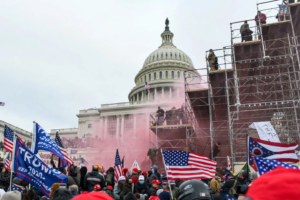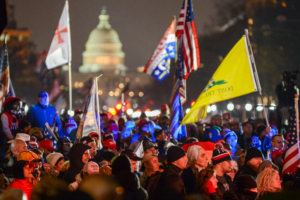Issue of the Week: Human Rights


Inside the Capitol Riot: An Exclusive Video Investigation, The New York Times, June 30, 2021
The US is two days away from the Fourth of July weekend. This Sunday will be the first Independence Day, beginning during the American Revolution of what concluded in the founding of the democratic republic of the United States, since the attempt to stop the constitutional process of Congress counting and certifying the vote for president on January 6, 2021 and to destroy the US democratic republic in its 244th year.
It came perilously close to succeeding.
Fortunately, the majority of Americans did and do find this action to be contemptible and treasonous, which the attempted ovethrow of the democratically elected government was and is by definition.
However, a significant minority of Americans in effect enabled this insurrection, fed by the demonstrable lie of a fraudulent election, which, it has just been revealed, even former Attorney General Bill Barr bluntly told Donald Trump that it was–a lie.
The context which led to this, an utterly inconceivable act in modern American history before it happened, after numerous utterly inconceivable acts for the past few years, has been explored by us for years and will be further. It is not a partisan context in the end, nor just an American context, but a global one, as all things are now. The relief of most global leaders and global opinion across the political spectrum at the return to norms by Joe Biden has been palpable, if tentative, because of the shock at what already happened and fear that it could again.
Because the context which led to this could still lead to what January 6 attempted.
In the end, what happens in the US is up to all adult citizens, just as what happens globally is up to all adults. This has before and may again in some instances require the greatest of sacrifices in standing up to power that defiles human rights, allows inequality and injustice and risks the very environment that sustains all life.
In honor of this Fourth of July weekend, we defer to the video investigation of the January 6 attack on the Capitol, worked on for the past six months and released today by The New York Times. Few things could ever be so important, so powerful, so meaningful, or so completely speak for itself.
Here is the introduction in print and link to the 40-minute video:
“Inside the Capitol Riot: An Exclusive Video Investigation”
By The New York Times, June 30, 2021
The Times analyzed thousands of videos from the Jan. 6 attack on the U.S. Capitol Building to understand how it happened — and why. Here are some of the key findings.
In the six months since an angry pro-Trump mob stormed the U.S. Capitol, immense efforts have been made not only to find the rioters and hold them accountable, but also — and perhaps more important — to dig into the details of Jan. 6 and slowly piece together what actually happened that day.
Congressional committees have looked into police and intelligence failures. The Justice Department has launched a nationwide investigation that has now resulted in more than 500 arrests. And while Republicans in Congress blocked the formation of a blue-ribbon bipartisan committee, House Democrats are poised to appoint a smaller select committee.
Even now, however, Republican politicians and their allies in the media are still playing down the most brazen attack on a seat of power in modern American history. Some have sought to paint the assault as the work of mere tourists. Others, going further, have accused the F.B.I. of planning the attack in what they have described — wildly — as a false-flag operation.
The work of understanding Jan. 6 has been hard enough without this barrage of disinformation and, hoping to get to the bottom of the riot, The Times’s Visual Investigations team spent several months reviewing thousands of videos, many filmed by the rioters themselves and since deleted from social media. We filed motions to unseal police body-camera footage, scoured law enforcementradio communications, and synchronized and mapped the visual evidence.
What we have come up with is a 40-minute panoramic take on Jan. 6, the most complete visual depiction of the Capitol riot to date. In putting it together, we gained critical insights into the character and motivation of rioters by experiencing the events of the day often through their own words and video recordings. We found evidence of members of extremist groups inciting others to riot and assault police officers. And we learned how Donald J. Trump’s own words resonated with the mob in real time as they staged the attack.
Here are some of the major revelations.
Multiple Points of Attack
We pinpointed at least eight locations where rioters breached and entered the Capitol building — more than were previously known. The scenes revealed the extent of the rioters’ disregard for the law as they surged violently around the building’s perimeter and, eventually, inside.
The police were outnumbered and responded differently at various breach points, allowing rioters to break through doors using weapons like crowbars or, in some places, to simply walk through as the police stepped aside.
The multiple breaches also revealed the Capitol’s vulnerability. Despite locked doors and, in certain places, thick windows, rioters without specialized equipment were able to break in instantly in some places.
A Delay Turns Deadly
In the Senate, proceedings to certify the election results were halted almost immediately when a building-wide lockdown was called after the first breach by rioters. But we found that it took much longer for the House of Representatives to do the same. This delay appeared to have contributed to a rioter’s death.
Instead of evacuating, members of the House sheltered in place and resumed their work even as rioters overran the building. Speaker Nancy Pelosi was rushed to safety, but Representative Jim McGovern took her place presiding over the session. He told us that Capitol building security staff had said it was safe to resume.
Eventually, the House session was halted and members began streaming out of a rear door guided by security personnel. Rioters had arrived at almost the same moment, just on the other side of a hallway door with glass panels. They became incensed at the sight of the evacuating lawmakers — a situation that could have been avoided if the lawmakers had left before the mob arrived.
Ashli Babbitt, a Trump supporter and follower of the QAnon conspiracy theory, tried to climb through one of the door’s broken windows toward the lawmakers. A plainclothes Capitol Police officer charged with protecting the House shot her once through the upper chest. The wound was fatal.
The Makeup of the Mob
One of the biggest questions hanging over the aftermath of Jan. 6 was whether the riot was planned and carried out by organized groups.
By identifying and tracking key players throughout the day, we found that most — even some at the forefront of the action — were ardent, but disorganized Trump supporters swept up in the moment and acting individually.
The first person to enter the Capitol building, for example, was a 43-year-old husband and father from Kentucky named Michael Sparks. He has no known affiliation with any organized groups. Ray Epps, an Arizona man seen in widely-circulated videos telling Trump supporters on multiple occasions to go into the Capitol, also seemed to have acted on his own.
Yet we also found that the crowd did include members of groups who seemed eager for a confrontation, like well-organized militias and far-right groups including the Oath Keepers and the Proud Boys. This proved to be a combustible mix. In the videos we analyzed, they can be seen with baseball bats and body armor, and coordinating with one another using radios. On several occasions, a calculated move by a more organized actor — for example, a Proud Boy identifying a weakness in the police line near a set of stairs — set off a surge by the mob.
Evidence collected by the F.B.I. suggests that the Proud Boys in particular were aware that they had inflamed the mob of ordinary people — and may have intended to do so in advance. Just before the assault, one Proud Boy leader wrote on a group chat on Telegram that he was hoping his men could incite the “normies” to “burn that city to ash today” and “smash some pigs to dust.” Then, after the riot, another Proud Boy leader wrote on Telegram: “This is NOT what I expected to happen. All from us showing up and starting some chants and getting the normies all riled up.”
Domino Effect
By synchronizing footage from both sides of the Capitol building, we were able to establish how crowds on each side interacted with one another.
We tracked the movement of a group of rioters from the west side of the Capitol — which faces the National Mall and absorbed most of the attendees arriving from Mr. Trump’s speech — to the opposite eastern side.
The eastern crowd had remained largely behind the barricades, but all that changed with the arrival of rioters from around the side of the building. This more violent group was the trigger that put the entire mob over the edge, spurring them to push easily through a line of officers and surround the Capitol on every front.
Echoing the President
Most of the videos we analyzed were filmed by the rioters. By carefully listening to the unfiltered chatter within the crowd, we found a clear feedback loop between President Trump and his supporters.
As Mr. Trump spoke near the White House, supporters who had already gathered at the Capitol building hoping to disrupt the certification responded. Hearing his message to “walk down to the Capitol,” they interpreted it as the president sending reinforcements. “There’s about a million people on their way now,” we heard a man in the crowd say, as Mr. Trump’s speech played from a loudspeaker.
The call and response didn’t stop there. We found evidence of his influence once the violence was well underway. In one moment, a woman with a megaphone urged rioters to climb through a broken window by asking them to “stand up for our country and Constitution” — echoing the language in an earlier tweet from Mr. Trump. In another, as the police were pushing to clear the mob off the building, a rioter screamed at officers: “I was invited here by the president.”
Taking Back the Capitol
One unanswered question when we began this investigation was how the police managed to reclaim the Capitol building from the mob. We found that once officers increased their numbers, armor and crowd-control weapons, clearing the rioters happened quickly and effectively.
The footage revealed that officers cleared several locations in less than an hour after being reinforced by local Metropolitan Police, Virginia State Police and other local and federal agencies that arrived with more manpower and authorization to use more powerful crowd-control weapons.
It’s a stark contrast to what we saw during the Black Lives Matter protests in the summer of 2020, when federal officers were on scene from the start, already equipped with riot gear and authorized to use higher levels of force. Law enforcement’s relatively quick success in clearing the Capitol building once reinforcements arrived shows how the rioters might have been stopped far earlier with a different level of preparation — possibly preventing fatalities, countless officer injuries, over $30 million in damages.
There was another difference between the Capitol riot and those connected to this summer’s racial justice protests: Very few people who broke into the Capitol were arrested at the scene. Most were allowed to leave the building, forcing the F.B.I. to track them down later and take them into custody — a process that is still continuing today.